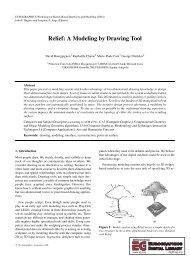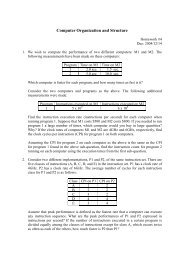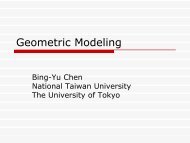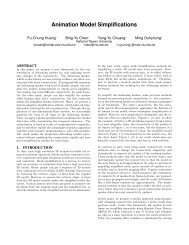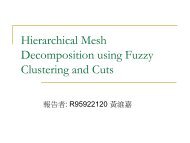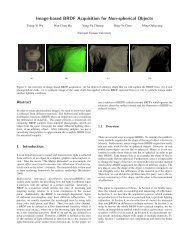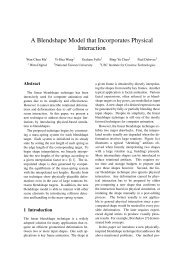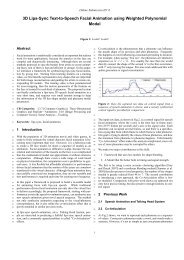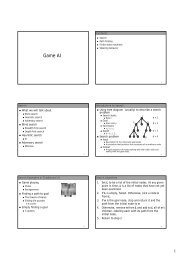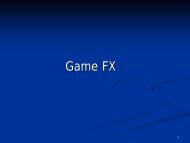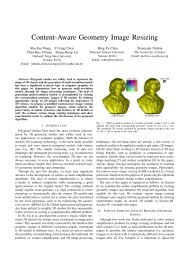Lips-Sync 3D Speech Animation using Compact Key-Shapes
Lips-Sync 3D Speech Animation using Compact Key-Shapes
Lips-Sync 3D Speech Animation using Compact Key-Shapes
Create successful ePaper yourself
Turn your PDF publications into a flip-book with our unique Google optimized e-Paper software.
space whereas the skew component S i j in Euclidean space. Thenon-linear convolution is computed as follows:M(T j K,α) = exp( ∑ log(R i j K)α i )( ∑ S i j α i )i=1i=1Using exponential map to blend example meshes, we can get ourresult mesh as :V,α = argmin v∗ ,α ∗‖Gv − M(F,α)‖ (1)subject to X ∈ v be equal to constraints C. Details and solution to thenon-linear minimization is refereed to Sumner et al.[Sumner et al.2005], where a Gauss-Newton method was utilized to linearizes theequation and solved in a iterative manner. In latter discussion, resultα will be used as parameter for our training. Given α, we are able torecover position v by first computing the deformation gradient ¯F =M(F,α), and plugging in Eq.2 to solve directly without iteration.V = argmin v ∗‖Gv − M(F,α)‖ (2)4 Capture and PreprocessingA SONY DCR TRV 900 video camera is used for the capture purpose.The camera is placed in frontal direction toward face of thetracked subject. The subject is placed with 15 landmarks around thelips and jaw for easier tracking, as in Fig 3, though not absolutelynecessary. The result contains about 10 minutes video, approximately18000 frames. The subject is asked to speak contents thatelicit no emotion, and these contents also includes bi-phone andtri-phone to reflect co-articulation.4.1 Feature TrackingThe result of recording video is subsequently tracked <strong>using</strong> a customizedtracker. Although various tracking algorithm exist, LucasKanade Tomasi(KLT) tracker, a direct tracking method based onconstancy of feature brightness, is used in the paper.Other popular tracker such as Active AppearanceModel(AAM)/variation, a trainable model that separates structureof images from texture and learns basis <strong>using</strong> PCA, is ideal foron-line purpose, is, however, not necessary for our databasebuilding.Figure 4: The figure indicate the overview of our system includingthe data capture and processing step.4.2 Phoneme SegmentationEach frame of the recorded sequence corresponds to a phoneme thesubject speaks, and given transcript, the CMU SphinxII can decodethe audio and cut the utterance into a sequence of phoneme segments.The CMU SphonxII use 51 phonemes, including 7 sounds,1 silence, and 43 phonemes, to construct the dictionary.The result of preprocessing after feature tracking and phoneme segmentationcontain a list of data of 15 dimensionality for each frameassociated with a specific phoneme Sphinx II defines.5 Algorithm5.1 OverviewAfter the capture of the performer and subsequent tracking andphone alignment, the artist is ready to create certain <strong>3D</strong> face modelsthat can be useful for interpolating examples. In section 5.2a discussion of how to cluster training data without knowing howmany groups needed is given, where affinity propagation [Frey andDueck 2007] is exploited. The result instructs artists to sculpt <strong>3D</strong>face models that correspond to certain key-shapes in the trainingsample, and a method in section 5.3 is introduced to solve the followinganalogy:Training exp :: Training neut = ? :: FaceModel neutSuch analogy is solved with the algorithm from Sumner etal.[Sumner et al. 2005], and we can obtain a high dimensional parameterfor each frame of the training data that correspond to eachphoneme the performer speak. After that, relationship can be builtwith Gaussian estimation for each phoneme, similar to the work byEzzat et al.[Ezzat et al. 2002]. In section 5.4, an energy function ispresented to synthesize any novel speech for new parameters thatcan composite a sequence of <strong>3D</strong> facial animation.Figure 3: 18 landmarks are placed on the face, 3 for position stabilization,and 15 are used for tracking (12 around lips, and 3 on jaw).Sometimes mis-tracked/lost features require the user to bring back.5.2 Prototype Image-Model Pairs IdentificationSince our method highlights example-based interpolation, representativeprototype lips-shapes as key-shapes have to be identified.Without lose of generality, fewer key-shapes are desired, since to



